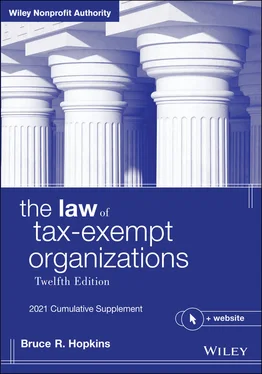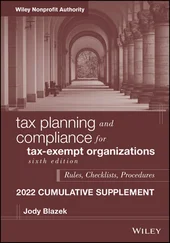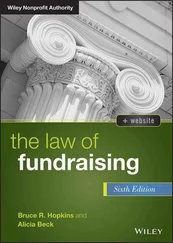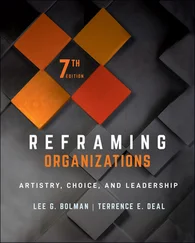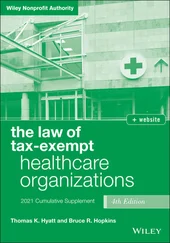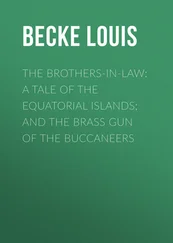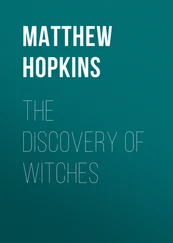Bruce R. Hopkins - The Law of Tax-Exempt Organizations, 2021 Cumulative Supplement
Здесь есть возможность читать онлайн «Bruce R. Hopkins - The Law of Tax-Exempt Organizations, 2021 Cumulative Supplement» — ознакомительный отрывок электронной книги совершенно бесплатно, а после прочтения отрывка купить полную версию. В некоторых случаях можно слушать аудио, скачать через торрент в формате fb2 и присутствует краткое содержание. Жанр: unrecognised, на английском языке. Описание произведения, (предисловие) а так же отзывы посетителей доступны на портале библиотеки ЛибКат.
- Название:The Law of Tax-Exempt Organizations, 2021 Cumulative Supplement
- Автор:
- Жанр:
- Год:неизвестен
- ISBN:нет данных
- Рейтинг книги:5 / 5. Голосов: 1
-
Избранное:Добавить в избранное
- Отзывы:
-
Ваша оценка:
- 100
- 1
- 2
- 3
- 4
- 5
The Law of Tax-Exempt Organizations, 2021 Cumulative Supplement: краткое содержание, описание и аннотация
Предлагаем к чтению аннотацию, описание, краткое содержание или предисловие (зависит от того, что написал сам автор книги «The Law of Tax-Exempt Organizations, 2021 Cumulative Supplement»). Если вы не нашли необходимую информацию о книге — напишите в комментариях, мы постараемся отыскать её.
The Law of Tax-Exempt Organizations, 2021 Cumulative Supplement — читать онлайн ознакомительный отрывок
Ниже представлен текст книги, разбитый по страницам. Система сохранения места последней прочитанной страницы, позволяет с удобством читать онлайн бесплатно книгу «The Law of Tax-Exempt Organizations, 2021 Cumulative Supplement», без необходимости каждый раз заново искать на чём Вы остановились. Поставьте закладку, и сможете в любой момент перейти на страницу, на которой закончили чтение.
Интервал:
Закладка:
§ 8.4 INSTRUCTION OF INDIVIDUALS
p. 217, note 103. Insert following existing text:
If this type of activity, however, is or becomes more in the nature of business promotion, however, the private benefit doctrine (see § 20.13) will preclude exemption (e.g., Priv. Ltr. Rul. 201927022).
§ 8.5 INSTRUCTION OF PUBLIC
p. 222, first complete paragraph. Insert as last sentence:
Somewhat similarly, an organization will not be considered by the IRS to be educational if more than an insubstantial amount of the entity's activities is social in nature. 161.1
Notes
1 10.1 Priv. Ltr. Rul. 202019028.
2 45.1 Mayo Clinic v. United States, 412 F. Supp. 3d 1038, 1057 (D. Minn. 2019).
3 45.2 Id. at 1047.
4 45.3 Id.
5 45.4 See § 7.6(a).
6 45.5 This is one of the contextual canons used in construing statutes; it is a presumption of consistent usage. See Scalia & Garner, Reading Law: The Interpretation of Legal Texts 170 (Thomson/West, St. Paul, MN: 2012).
7 45.6 This is the whole‐text canon (Reading Law, supra, note 45.5, at 1167). In this case, the court did not read “all parts of the statute together”; it read only two sections of it (IRC § 170(b)(1)(A)(ii) and (iii)). The entire statute is IRC § 170(b)(1)(A), where the law provides for nine categories of public charities, eight of which do not contain the primary‐function requirement. It is probable that the statute writers had a reason to insert the requirement only in IRC § 170(b)(1)(A)(iii), a point the court did not explore.
8 45.7 The IRS calculated that the Mayo Clinic's educational activities were only 13 percent of its total activities and that its revenue from educational undertakings was only 6 percent of total revenue (Tech. Adv. Mem. 201407024). The court in this case may have violated another contextual canon: the absurdity doctrine. This canon states that a provision may be judicially corrected where the failure to do so would result in a disposition that no reasonable person could approve (Reading Law, supra, note 45.5, at 234). Indeed, another contextual canon the court could have applied is the harmonious‐reading canon, pursuant to which the provisions of a text should be interpreted in a way that renders them compatible, not contradictory (id., at 180).
9 161.1 E.g., Priv. Ltr. Rul. 201852020.
CHAPTER NINE Scientific Organizations
§ 9.2 Concept of Research
§ 9.2 CONCEPT OF RESEARCH
p. 231, second paragraph. Insert as last sentence:
Also, the promotion of blockchain technology for the benefit of payors, providers, and financial institutions in the health care context was ruled by the IRS to not be scientific research. 18.1
Note
1 18.1 Priv. Ltr. Rul. 201918019.
CHAPTER TEN Religious Organizations
§ 10.1 Constitutional Law Framework(a) General Constitutional Law Principles (c) Internal Revenue Code Provisions
§ 10.2 Federal Tax Law Definition of Religion (c) Abuse of Tax Exemption
§ 10.3 Churches and Similar Institutions(c) Principle of Respect for Autonomy
§ 10.5 Integrated Auxiliaries of Churches
§ 10.7 Religious Orders
§ 10.1 CONSTITUTIONAL LAW FRAMEWORK
(a) General Constitutional Law Principles
p. 239, last paragraph. Insert as last sentence:
In a similar holding, the Court held that states, once having implemented a program providing financial assistance (such as scholarships) for access to private schools, cannot exclude religious schools from participation in the program; a state supreme court's striking down such a program, on the ground it violates the state's constitution, was held to transgress the free exercise clause. 27.1
p. 239, note 20. Insert following existing text:
The Supreme Court struck down a state executive order imposing restrictions on the size of gatherings in houses of worship, in an effort to control the spread of the coronavirus, because the limits were found excessively strict (Roman Catholic Diocese of Brooklyn v. Cuomo, 141 S. Ct. 63 (2020)). A similar case is under reconsideration, following remand by the Court (Harvest Rock Church v. Newsom (C.D. Cal.)).
p. 242, note 61. Delete 134 S. Ct. 1811 and insert 572 U.S. 565.
p. 242, note 61. Insert following existing text:
This decision has given rise to a historical significance test, where courts ascertain whether a statute is a continuation of a “historical practice” of Congress ( id . at 576).
(c) Internal Revenue Code Provisions
p. 247, note 102. Insert following existing text:
On appeal, this decision was reversed, with the appellate court ruling that this rental allowance is not unconstitutional as a violation of the establishment clause because the provision has secular purposes and it passed a historical significance test (Gaylor v. Mnuchin, 919 F.3d 420 (7th Cir. 2019)). The secular purposes were said to be elimination of discrimination against ministers, elimination of discrimination between ministers, and avoidance of excessive government entanglement with religion. As to the historical significance test, see supra note 61 and text accompanying it.
§ 10.2 FEDERAL TAX LAW DEFINITION OF RELIGION
(c) Abuse of Tax Exemption
p. 254, note 165. Insert following existing text:
An individual selling religious merchandise by means of the internet was found liable for federal income tax on the net proceeds, with a court rejecting his argument that he was functioning as a church (Lloyd v. Comm'r, T.C. Memo. 2020‐92 (2020).
§ 10.3 CHURCHES AND SIMILAR INSTITUTIONS
(c) Principle of Respect for Autonomy
p. 262, note 219, second line. Insert following third period:
The Court expanded the ministerial exception to encompass teachers employed by religious schools (Our Lady of Guadalupe School v. Morrissey‐Berru; St. James School v. Darryl Biel, 140 S. Ct. 2049).
§ 10.5 INTEGRATED AUXILIARIES OF CHURCHES
p. 263, note 233. Delete 26.9 and insert 26.11.
§ 10.7 RELIGIOUS ORDERS
p. 266. Insert as second complete paragraph, before heading:
A tax‐exempt religious organization is inspired by Christian ideals and structured around daily religious observations and celebrations of festivals of the Christian year. This entity is dedicated to the care and well‐being of adults with developmental disabilities—its residents. The community also includes members who care for the residents and the members' children. These three categories of individuals live together on a full‐time basis in extended family households and work together maintaining the community. Members are individuals who have been in continuous residence at the organization's facility for at least three years, completed a course of studies, completed a discernment process regarding the suitability of their intended permanent commitment to the community, and been accepted into permanent residence at the community. Members agree to strive to live in accordance with ideals requiring moral and spiritual self‐sacrifice and dedication to the organization's goals, at the expense of their material well‐being. The IRS ruled that this organization is a religious order, even though it is not under the control and supervision of a church or convention or association of churches. 252.1
Читать дальшеИнтервал:
Закладка:
Похожие книги на «The Law of Tax-Exempt Organizations, 2021 Cumulative Supplement»
Представляем Вашему вниманию похожие книги на «The Law of Tax-Exempt Organizations, 2021 Cumulative Supplement» списком для выбора. Мы отобрали схожую по названию и смыслу литературу в надежде предоставить читателям больше вариантов отыскать новые, интересные, ещё непрочитанные произведения.
Обсуждение, отзывы о книге «The Law of Tax-Exempt Organizations, 2021 Cumulative Supplement» и просто собственные мнения читателей. Оставьте ваши комментарии, напишите, что Вы думаете о произведении, его смысле или главных героях. Укажите что конкретно понравилось, а что нет, и почему Вы так считаете.
